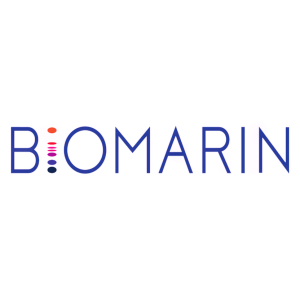BioMarin Presents Five-Year Phase 3 Results Reinforcing Long-Term Efficacy and Safety of ROCTAVIAN® (valoctocogene roxaparvovec-rvox) at International Society on Thrombosis and Haemostasis 2025 Congress
Rhea-AI Summary
BioMarin (NASDAQ:BMRN) presented compelling five-year Phase 3 results for ROCTAVIAN®, their gene therapy treatment for severe hemophilia A, at the ISTH 2025 Congress. The GENEr8-1 trial demonstrated sustained efficacy with mean Factor VIII activity remaining in the mild hemophilia range (24.0 IU/dL one-stage assay), and 73.5% of participants maintaining FVIII levels in the mild-to-normal range.
Key outcomes after five years include: 81.3% of participants remaining off prophylaxis, mean annualized bleeding rate of just 0.6 bleeds/year, and 77.8% of participants experiencing zero treated bleeds during year five. The study confirmed consistent safety with no new signals, no FVIII inhibitors, no thromboembolic events, and no treatment-related malignancies.
Positive
- 81.3% of participants remained off prophylaxis after 5 years
- Strong safety profile with no new safety signals, inhibitors, or treatment-related malignancies
- Low mean annualized bleeding rate of 0.6 bleeds/year after 5 years
- 73.5% of participants maintained FVIII levels in mild-to-normal range
- 77.8% of participants had zero treated bleeds during year five
- Improved quality of life measures across multiple dimensions
Negative
- One adult patient returned to prophylaxis since last data cut
- Two patients discontinued the study prior to year five
Insights
BioMarin's 5-year ROCTAVIAN data shows sustained efficacy with 81.3% remaining off prophylaxis and favorable safety profile, strengthening commercial prospects.
The five-year data from BioMarin's Phase 3 GENEr8-1 trial represents a significant milestone for ROCTAVIAN, their gene therapy for severe hemophilia A. The results show remarkable durability with FVIII activity levels remaining in the mild hemophilia range (mean one-stage assay =
The clinical outcomes are equally impressive:
The safety profile remains clean with no new signals emerging over five years – importantly, no participants developed inhibitors to FVIII (a potential complication), experienced thromboembolic events, or developed treatment-related malignancies. This long-term safety data is essential for a gene therapy that involves genetic modification.
The "hemophilia-free mind" framework data is particularly valuable as it quantifies quality-of-life improvements across multiple dimensions that matter to patients. This holistic approach to measuring outcomes strengthens ROCTAVIAN's value proposition beyond just clinical metrics.
For severe hemophilia A patients, these results validate ROCTAVIAN as a potential one-time treatment that could replace years of prophylactic factor infusions, substantially reducing treatment burden while maintaining excellent bleed control. This long-term data should enhance physician and patient confidence in adopting this gene therapy approach.
Data from longest and largest hemophilia gene therapy study demonstrates sustained factor VIII expression and bleed control, with
No new safety signals observed
The Phase 3 GENEr8-1 trial demonstrated that durable bleed control and sustained factor VIII (FVIII) expression were maintained five years after treatment with ROCTAVIAN. FVIII activity remained consistent with previously reported results, and no new safety signals were observed. Across the entire trial, no participants developed FVIII inhibitors or experienced thromboembolic events, and there were no treatment-related malignancies across the five years of the study.
"I am impressed that the strong efficacy and safety results for ROCTAVIAN are sustained five years after individuals with severe hemophilia A received gene therapy, with only one adult returning to prophylaxis since the last data cut," said Andrew Leavitt, M.D., director of the University of California San Francisco's program for noncancerous blood disorders and Adult Hemophilia Treatment Center. "These results highlight the role that gene therapy may play in addressing the burdens of chronic disease management in people living with hemophilia A, while maintaining excellent bleed control."
Among the 134 individuals who received ROCTAVIAN in the study, the rollover population of 112 patients from the 270-902 noninterventional lead-in study had baseline annualized bleeding rate (ABR) data prospectively collected during a period of at least six months while on routine FVIII prophylaxis prior to receiving ROCTAVIAN, and two of the 112 patients discontinued the study prior to year five.
After five years, FVIII activity was nearly stable compared to year four, with mean FVIII activity in the mild hemophilia range (one-stage assay = 24.0 IU/dL; chromogenic assay = 13.7 IU/dL);
"We hope these results demonstrating the long-term durability of gene therapy equip individuals with severe hemophilia A with the knowledge to make informed decisions regarding treatment," said Dawn Rotellini, Chief Operating Officer at the National Bleeding Disorders Foundation. "It is meaningful for the bleeding disorders community to see a continued commitment to highlighting the benefits of hemophilia A gene therapy."
Additional data presented at the meeting described a framework for the measurement of the "hemophilia-free mind" in people who have received a ROCTAVIAN infusion, which represents an easing of the physical and psychological burden of hemophilia. Researchers leveraged clinical data as well as questionnaires to assess a number of quality of life outcomes from baseline to week 104. The analysis showed that people who received ROCTAVIAN in the Phase 3 GENEr8-1 study experienced improvements across all measures, including bleeding risk, joint pain, injection schedule, physical activity, travel, employment and education, and impact on family members and caregivers.
"These five-year data reinforce our confidence in ROCTAVIAN's profile, showing that people living with severe hemophilia A can experience long-term bleed control without the need for prophylaxis, meaningfully impacting the mental and clinical burdens of this condition," said Greg Friberg, M.D., Executive Vice President and Chief Research & Development Officer at BioMarin. "We remain committed to supporting the medical community and individuals living with severe hemophilia A in the clinical adoption of this gene therapy so they can experience the benefits that this treatment can offer."
Below are key presentations for BioMarin and ROCTAVIAN at ISTH (all times Eastern Daylight Time):
Efficacy, Safety and Quality of Life 5 Years After Valoctocogene Roxaparvovec Gene Transfer
Poster PB0804
Monday, June 23, 2025, 1:45 – 2:45 p.m.
Final Analysis of the Phase 1/2 Trial of Valoctocogene Roxaparvovec for Severe Hemophilia A
Poster PB0822
Monday, June 23, 2025, 1:45 – 2:45 p.m.
Impact of Valoctocogene Roxaparvovec on Hemophilia-Free Mind: A Visual Multidimensional Method
Poster PB0838
Monday, June 23, 2025, 1:45 – 2:45 p.m.
Mechanisms of AAV Vector Persistence Following Infant Gene Therapy in Severe Hemophilia A Dogs
Oral OC 51.1
Tuesday, June 24, 2025, 9:30 – 9:45 a.m.
Steady Musculoskeletal Health After Gene Therapy in Severe Hemophilia A: 5-Year Results
Oral OC 69.1
Wednesday, June 25, 2025, 10:15 – 10:30 a.m.
About Hemophilia A
Hemophilia A, also called factor VIII (FVIII) deficiency or classic hemophilia, is an X-linked genetic condition caused by missing or defective FVIII, a clotting protein. Although it is passed down from parents to children, about one-third of cases are caused by a spontaneous mutation, a new mutation that was not inherited. Approximately 1 in 10,000 people have hemophilia A.
About ROCTAVIAN
ROCTAVIAN is an adeno-associated virus vector-based gene therapy used for the treatment of adults with severe hemophilia A who do not have antibodies to adeno-associated virus serotype 5 (AAV5), which is determined by a blood test. The one-time infusion works by delivering a functional gene that is designed to enable the body to produce FVIII on its own, reducing the need for ongoing prophylaxis.
The European Commission (EC) granted conditional marketing authorization to ROCTAVIAN on August 24, 2022. The
More information on testing to determine eligibility to receive ROCTAVIAN can be found at https://www.ROCTAVIAN.com in the
ROCTAVIAN
Contraindications: Patients with active infections, either acute (such as acute respiratory infections or acute hepatitis) or uncontrolled chronic (such as chronic active hepatitis B). Patients with known significant hepatic fibrosis (stage 3 or 4 on the Batts-Ludwig scale or equivalent), or cirrhosis, and patients with known hypersensitivity to mannitol.
Infusion-related reactions including hypersensitivity reactions and anaphylaxis, have occurred. Monitor during and for at least 3 hours after ROCTAVIAN administration. Administer ROCTAVIAN in a setting where personnel and equipment are immediately available to treat infusion-related reactions. Discontinue infusion for anaphylaxis.
Hepatotoxicity: The safety and effectiveness of ROCTAVIAN in patients with hepatic impairment has not been established. Perform liver health assessments prior to administration. The majority of patients treated with ROCTAVIAN experienced ALT elevations and required corticosteroids for ALT elevation. Assess patient's ability to receive corticosteroids and/or other immunosuppressive therapy that may be required for an extended period. Live vaccines should not be administered to patients while on immunosuppressive therapy.
Monitor ALT weekly for at least 26 weeks and as clinically indicated, during corticosteroid therapy and institute corticosteroid treatment in response to ALT elevations as required. Continue to monitor ALT until it returns to baseline. Monitor factor VIII activity levels since ALT elevation may be accompanied by a decrease in factor VIII activity. One case of autoimmune hepatitis was reported during third year follow-up in a patient with history of hepatitis C and steatohepatitis.
It is recommended that patients abstain from consuming alcohol for at least 1 year after administration and thereafter limit alcohol use. Concomitant medications may cause hepatotoxicity, decrease factor VIII activity, or change plasma corticosteroid levels which may impact liver enzyme elevation and/or factor VIII activity or decrease the efficacy of the corticosteroid regimen or increase their side effects. Closely monitor concomitant medication use including herbal products and nutritional supplements and consider alternative medications in case of potential drug interactions.
Thromboembolic events: Factor VIII activity above ULN has been reported following ROCTAVIAN infusion. Thromboembolic events may occur in the setting of elevated factor VIII activity above ULN. Evaluate patients for risk of thrombosis including general cardiovascular risk factors before and after administration of ROCTAVIAN. Advise patients on their individual risk of thrombosis in relation to their factor VIII activity levels above ULN and consider prophylactic anticoagulation. Advise patients to seek immediate medical attention for signs or symptoms indicative of a thrombotic event.
Factor VIII inhibitors and Monitoring for inhibitors: The safety and effectiveness of ROCTAVIAN in patients with prior or active factor VIII inhibitors have not been established. Patients with active factor VIII inhibitors should not take ROCTAVIAN. Following administration, monitor patients for factor VIII inhibitors (neutralizing antibodies to factor VIII). Test for factor VIII inhibitors especially if bleeding is not controlled, or plasma factor VIII activity levels decrease.
Monitor Factor VIII using the same schedule for ALT monitoring. It may take several weeks after ROCTAVIAN infusion before ROCTAVIAN-derived factor VIII activity rises to a level sufficient for prevention of spontaneous bleeding episodes. Exogenous factor VIII or other hemostatic products may also be required in case of surgery, invasive procedures, trauma, or bleeds. Consider more frequent monitoring in patients with factor VIII activity levels ≤ 5 IU/dL and evidence of bleeding, taking into account the stability of factor VIII levels since the previous measurement.
Factor VIII activity produced by ROCTAVIAN in human plasma is higher if measured with one-stage clotting assays compared to chromogenic substrate assays. When switching from hemostatic products prior to ROCTAVIAN treatment, physicians should refer to the relevant prescribing information to avoid the potential for factor VIII activity assay interference during the transition period.
Malignancy: The integration of liver-targeting AAV vector DNA into the genome may carry the theoretical risk of hepatocellular carcinoma development. ROCTAVIAN can also insert into the DNA of other human body cells. Monitor patients with risk factors for hepatocellular carcinoma (e.g., hepatitis B or C, non-alcoholic fatty liver disease, chronic alcohol consumption, non-alcoholic steatohepatitis, advanced age) with regular liver ultrasound (e.g., annually) and alpha-fetoprotein testing for 5 years following ROCTAVIAN administration. In the event that any malignancy occurs after treatment with ROCTAVIAN, contact BioMarin Pharmaceutical Inc. at 1-866-906-6100.
Most Common Adverse Reactions: Most common adverse reactions (incidence ≥
Isotretinoin, Efavirenz, and HIV Positive Patients: Isotretinoin is not recommended in patients who are benefiting from ROCTAVIAN. Efavirenz is not recommended in patients treated with ROCTAVIAN. Clinical studies of ROCTAVIAN did not include sufficient numbers of patients with HIV to determine whether the efficacy and safety differs compared to patients without HIV infection.
Females and Males of Reproductive Potential: ROCTAVIAN is not intended for administration in women. There are no data on the use of ROCTAVIAN in pregnant women or regarding lactation. For 6 months after administration of ROCTAVIAN, men of reproductive potential and their female partners must prevent or postpone pregnancy using an effective form of contraception, and men must not donate semen.
You may report side effects to the FDA at (800) FDA-1088 or www.fda.gov/medwatch. You may also report side effects to BioMarin at 1-866-906-6100.
Please see the ROCTAVIAN full Prescribing Information for additional Important Safety Information.
About BioMarin
BioMarin is a global biotechnology company dedicated to translating the promise of genetic discovery into medicines that make a profound impact on the life of each patient. The
Forward-Looking Statements
This press release contains forward-looking statements about the business prospects of BioMarin Pharmaceutical Inc. (BioMarin), including without limitation, statements about: data presented at the 33rd Congress of the International Society on Thrombosis and Haemostasis (ISTH), including the oral and poster presentations; ROCTAVIAN's efficacy, safety and benefits to individuals with hemophilia A, including health-related quality of life; and BioMarin's commitment to supporting the medical community and individuals living with severe hemophilia A in the clinical adoption of ROCTAVIAN. These forward-looking statements are predictions and involve risks and uncertainties such that actual results may differ materially from these statements. These risks and uncertainties include, among others: BioMarin's success in the commercialization of ROCTAVIAN; results and timing of current and planned pre-clinical studies and clinical trials of ROCTAVIAN; any potential adverse events observed in the continuing monitoring of the patients in the clinical trials; the content and timing of decisions by the
BioMarin® and ROCTAVIAN® are registered trademarks of BioMarin Pharmaceutical Inc.
Contacts: | |
Investors | Media |
Traci McCarty | Katherine Powell |
BioMarin Pharmaceutical Inc. | BioMarin Pharmaceutical Inc. |
(415) 455-7558 | (415) 827-2968 |
![]() View original content to download multimedia:https://www.prnewswire.com/news-releases/biomarin-presents-five-year-phase-3-results-reinforcing-long-term-efficacy-and-safety-of-roctavian-valoctocogene-roxaparvovec-rvox-at-international-society-on-thrombosis-and-haemostasis-2025-congress-302488807.html
View original content to download multimedia:https://www.prnewswire.com/news-releases/biomarin-presents-five-year-phase-3-results-reinforcing-long-term-efficacy-and-safety-of-roctavian-valoctocogene-roxaparvovec-rvox-at-international-society-on-thrombosis-and-haemostasis-2025-congress-302488807.html
SOURCE BioMarin Pharmaceutical Inc.








